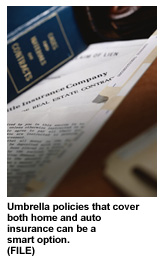|
Q&A: Life insurance
|
 |
November 16, 2000: 9:27 a.m. ET
Understand the benefits of 'umbrella' and variable life insurance policies
|
NEW YORK (CNNfn) - Umbrella policies that cover both home and auto insurance are inexpensive and can be a smart protection option. Also, variable universal life insurance policies do offer flexible premiums and other benefits to the policyholder if they are held until death.
Those are among the readers' questions answered this week by a panel of experts at the Consumer Federation of America (CFA).
Questions related to senior health insurance, including Medicare and long-term care policies, are fielded by Bonnie Burns, director of consumer education for California Health Advocates, the state's insurance counseling program. Check back each week to read the latest Q&A on our Insurance page.
Send CNNfn your insurance questions at insurance@cnnfn.com. Don't forget to include your first name and home town, which will be used . And keep in mind, not all questions can be answered.
Question: My husband and I have homes in both Minnesota and Wisconsin. We both have boats, snowmobiles and multiple cars, and life insurance. I am presently using 3 different companies to meet our insurance needs. I would like to know if there is a company that can help us with getting all these items under one policy. – Unnamed
Answer: I do not know of one policy that covers all of these diverse properties. You probably can get them all from one company. An insurer that specializes in "high end" insurance is Chubb. - Bob Hunter, CFA
Question: Are there general "rule-of-thumb" methods for determining appropriate coverages for home and auto insurance (i.e. for bodily injury/medical-income protection, property damage, uninsured/underinsured motorist, and personal liability)? Thanks – Brian
Answer: It is a good idea to find an umbrella policy to go over the auto and home policies and buy the minimum in the two underlying policies necessary to get the umbrella. Then buy an umbrella of at least $1 million over that. Umbrellas are inexpensive (about $300) for the first $1 million of coverage. You can pay for it by taking higher deductibles in the two underlying policies. This is a smart way to buy insurance, just like big corporations who self-insure a first layer and buy catastrophic protection at the top end. - Bob Hunter, CFA
Question: Are Variable Universal Life insurance policies (VULs) a good deal and if so, under what circumstances? – Steve
Answer: VULs, in which cash values are invested in mutual fund-like "separate accounts," can be a good deal only if they are held until death when any taxable gain that would apply on surrender (assuming investments have done well) disappears. We rather prefer cheap term life insurance policies and low-cost mutual funds, because they are easier to understand and because the array of commissions, fees, insurance charges (often higher than term), and asset charges for the insurer's investment management and profit can take away a lot of the VULs vaunted tax advantages. Ameritas has an excellent low-load VUL. Best use of a VUL is when the policy is held until death and the money is withdrawn, by partial withdrawals and low-cost loans, during retirement. – Jim Hunt, CFA
 Question: Why should I buy a permanent life insurance policy? – Patrick Question: Why should I buy a permanent life insurance policy? – Patrick
Answer: You should stick to term life unless he can afford the insurance he needs in a permanent policy, or he has maxed out on his 401(k)s, 403(b)s and Roth IRAs, or he has considered whether he should buy individual long-term disability protections, and finally, if he plans to keep the policy at least 20 years and preferably until death. In buying permanent insurance, compare the first-year premium to what term-life in the same face amount would cost. Then compare the difference to the first year surrender value (often cash-value less surrender charge.) If this first year cost seems a reasonable fee to pay, the policy may be a good investment for the long run. – Jim Hunt, CFA
Question: My son is a student at University of Maryland Baltimore County (UMBC). Before school started, the University Health Services offered health insurance plans to students. As a caring father, I paid for my son to enroll. Last year I paid $777 for the insurance. My son's left shoulder dislocated at the beginning of the year and used the insurance company's money around $200. This school year, my son filled out the application form with his credit card number and mailed it to the insurance company. The company didn't withdraw the money. I called two times asking what happened and they simply connected my call to the answering machine and didn't give me an answer. I think every student has the right to be protected. Student insurance should be a nonprofit organization. I have paid health insurance for my kids since they were in elementary school. This year was the first time we used the insurance company's money. Then they rejected my son's application. It makes me think that those insurance companies are cheaters. You pay the fee and you had better not use their money otherwise they don't deal with you anymore. - unnamed
Answer: I agree that this makes no sense at all. You should call the school and ask them to look into it. The school set up this plan and should be first to help you with a problem like this. If that doesn't work, you should ask the state insurance department in the state of the school to help. – Bob Hunter, CFA 
|
|
|
|
|
|
CNNfn’s Insurance Page
|
Note: Pages will open in a new browser window
External sites are not endorsed by CNNmoney
|
|
|
|
 |

|

